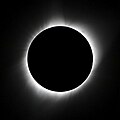| Annular eclipse | |
| Gamma | 0.7569 |
|---|---|
| Magnitude | 0.9367 |
| Maximum eclipse | |
| Duration | 335 s (5 min 35 s) |
| Coordinates | 51°18′N105°42′E / 51.3°N 105.7°E |
| Max. width of band | 354 km (220 mi) |
| Times (UTC) | |
| Greatest eclipse | 7:12:00 |
| References | |
| Saros | 122 (46 of 70) |
| Catalog # (SE5000) | 9046 |
An annular solar eclipse occurred at the Moon's descending node of orbit on Saturday, August 28, 1802, with a magnitude of 0.9367. A solar eclipse occurs when the Moon passes between Earth and the Sun, thereby totally or partly obscuring the image of the Sun for a viewer on Earth. An annular solar eclipse occurs when the Moon's apparent diameter is smaller than the Sun's, blocking most of the Sun's light and causing the Sun to look like an annulus (ring). An annular eclipse appears as a partial eclipse over a region of the Earth thousands of kilometres wide. Occurring only about 3 hours after apogee (on August 28, 1802, at 4:30 UTC), the Moon's apparent diameter was smaller. [1]
Contents
- Eclipse details
- Eclipse season
- Related eclipses
- Eclipses in 1802
- Metonic
- Tzolkinex
- Half-Saros
- Tritos
- Solar Saros 122
- Inex
- Triad
- Solar eclipses of 1801–1805
- Saros 122
- Metonic series
- Tritos series
- Inex series
- See also
- References
- External links
The path of annularity was visible from parts of modern-day Greenland, Svalbard, Russia, Mongolia, China, and the Ryukyu Islands. A partial solar eclipse was also visible for parts of Greenland, northern Canada, Europe, Asia, and western Alaska. [2]



































































































